When you get a wound, your body immediately starts working to repair the damage. One of the most visible steps in this process is the formation of a scab—a protective layer that covers the wound and creates a barrier against infection. Scabs are your body’s natural bandages, shielding the vulnerable skin underneath while new cells rebuild the tissue. But healing doesn’t always happen as quickly as we’d like. Sometimes wounds linger, remain moist, or reopen before they’re ready, which can delay scab formation and increase the risk of infection or scarring. That’s why many people wonder what they can do to help a wound scab over faster.
The process of wound healing involves several stages: inflammation, tissue formation, and remodeling. Scabbing occurs during the early tissue formation phase and is essential for allowing skin to regenerate without constant exposure to the outside world. If a wound doesn’t scab in a timely manner, it may take longer to close, stay vulnerable to bacteria, and become more uncomfortable. Fortunately, there are several effective strategies you can use to support this process. In this article, we’ll explore ten science-backed ways to speed up scabbing and help your body heal naturally and safely.
Clean the Wound Properly
The first and most important step in encouraging a wound to scab is to clean it thoroughly. Dirt, bacteria, or foreign objects can slow healing and prevent scab formation. Cleaning reduces the risk of infection and allows the healing process to begin without interference.
Use clean water to gently rinse the wound. If debris is present, try flushing it with a saline solution or gently removing it with sterilized tweezers. Avoid using hydrogen peroxide or alcohol unless absolutely necessary, as they can damage healthy cells and slow recovery. Pat the area dry with a clean cloth before applying any treatment.
Keep the Area Moist but Not Wet
Many people believe that letting a wound dry out will make it scab faster, but recent research shows that maintaining a slightly moist environment is actually better. Moisture supports the growth of new skin cells and reduces the chance of a scar. However, too much moisture can soften the scab or lead to maceration, where the skin becomes soggy and fragile.
The best way to achieve this balance is by using a thin layer of antibiotic ointment like petroleum jelly or a specialized wound gel. These products protect the skin while sealing in just enough moisture to support healing. Applying a non-stick bandage over the ointment can help regulate the environment and prevent drying or overexposure.
Avoid Picking at the Wound
It can be incredibly tempting to scratch, touch, or pick at a forming scab, especially when the wound itches. But this habit is one of the fastest ways to delay scabbing and healing. Interfering with the wound disrupts the fragile new skin cells and can restart the bleeding process, forcing your body to begin healing all over again.
Picking at a scab can also increase the risk of scarring or infection. Bacteria from your fingers can easily enter the wound, and repeated damage can make the area red, swollen, or even pus-filled. To avoid this, keep your hands away from the wound, and if the itching becomes unbearable, try using a cool compress or an anti-itch cream around the edges—but never directly on an open sore.
Protect the Wound from Friction and Pressure
Constant movement, rubbing, or pressure on a wound can interfere with scab formation. Whether it’s from clothing, sports equipment, or repetitive motion, friction can tear at healing tissue, slow cell repair, and prevent a stable scab from forming.
If your wound is located in an area that moves frequently—like a joint—or under tight clothing, try to minimize motion and use protective coverings. Flexible adhesive bandages, gauze wraps, or padded dressings can act as a buffer, allowing healing to continue undisturbed. In some cases, reducing physical activity that stresses the area may be necessary for faster results.
Eat Foods That Promote Skin Repair
Your body’s ability to heal quickly depends greatly on the nutrients it receives. Certain foods are particularly effective at supporting wound repair, including those rich in protein, vitamin C, zinc, and antioxidants. These nutrients help rebuild tissue, fight inflammation, and support the immune response.
Lean meats, fish, eggs, citrus fruits, berries, leafy greens, and nuts are excellent choices to include in your diet. Staying hydrated is just as important. Water helps deliver nutrients to skin cells and removes toxins from the body. If your diet lacks variety or you’re recovering from surgery, a multivitamin supplement may be beneficial to ensure you’re getting all the essentials.
Use Over-the-Counter Healing Ointments
There are numerous topical products designed specifically to speed up the wound healing process and encourage scabbing. These include antibiotic creams, hydrogel dressings, and silicone-based ointments. Each of these creates a protective barrier, keeps bacteria out, and locks in the right amount of moisture.
Some ointments also contain ingredients like allantoin or panthenol that help reduce irritation and stimulate new cell growth. Using these products as directed can create the optimal conditions for scab formation and reduce healing time. Be careful, however, not to overuse creams or reapply them excessively, as this can interfere with air flow or introduce contaminants.
Avoid Smoking and Alcohol
Healing is a full-body process, and substances like nicotine and alcohol can interfere with it from the inside out. Smoking restricts blood flow, reduces oxygen delivery to tissues, and weakens the immune response, all of which can delay scab formation and lead to chronic wounds. Alcohol dehydrates the body and impairs the function of cells involved in tissue repair.
If you’re trying to heal a wound quickly, consider reducing or eliminating these substances for at least a few weeks. Doing so can significantly improve your circulation and immune response, allowing your skin to recover more efficiently. Even temporary lifestyle changes can have a big impact on the speed of your recovery.
Keep the Wound at the Right Temperature
Temperature can also affect how quickly a wound scabs over. Cold environments may slow down blood flow and cellular activity, making healing less efficient. On the other hand, a slightly warm environment helps increase circulation and speeds up the delivery of oxygen and nutrients to the wound site.
This doesn’t mean applying heat directly to the wound, but rather keeping the area warm and covered when needed. If you’re often exposed to air conditioning or cold weather, consider wearing an extra layer or using a warming pad near—but not on—the injured skin. Ensuring that your whole body stays warm can support overall healing.
Get Plenty of Sleep
During sleep, the body enters a state of repair. Hormones that promote tissue regeneration are released, and the immune system becomes more active. When you don’t get enough rest, your body struggles to carry out these essential functions, which can significantly delay wound healing and scab formation.
Aim for at least 7 to 8 hours of sleep each night while you’re recovering. Creating a calming nighttime routine and avoiding screens before bed can help improve sleep quality. If stress or pain is keeping you awake, consider relaxation techniques like deep breathing or gentle stretches to wind down your nervous system.
Manage Chronic Health Conditions
Conditions like diabetes, poor circulation, or immune disorders can interfere with scab formation and wound healing. High blood sugar levels, for example, can impair blood flow and prevent white blood cells from fighting infection effectively. If you have a chronic condition, it’s especially important to keep it under control when you’re healing a wound.
Work closely with your doctor to manage medications, monitor symptoms, and make lifestyle adjustments as needed. Even small changes—like improved diet, regular checkups, or staying active—can lead to noticeable improvements in healing speed. Being proactive about your overall health ensures your body is fully equipped to close wounds quickly and efficiently.
Wound healing is a complex and dynamic process, but with the right care, you can help your body form a scab faster and heal more completely. From nutrition and sleep to protection and gentle hygiene, every step you take supports your skin’s recovery. By following these ten methods consistently, you not only shorten healing time but also reduce the risk of complications, discomfort, and long-term scarring. When in doubt, seek medical attention—especially if the wound worsens, refuses to scab, or shows signs of infection. Prompt, informed care is always your best defense.
Related Topics

































